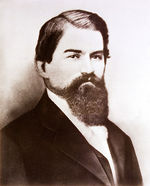John Pemberton
| John Stith Pemberton | |
|---|---|
 John Stith Pemberton |
|
| Born | July 8, 1831 Knoxville, Georgia |
| Died | August 16, 1888 (aged 57) Atlanta, Georgia |
| Resting place | Linwood Cemetery in Columbus, Georgia |
| Nationality | |
| Occupation | Druggist |
| Known for | Coca-Cola |
| Spouse | Ann Eliza Clifford Lewis |
| Children | Charles Ney Pemberton |
| Parents | James Clifford Pemberton, Martha L. Gant |
John Stith Pemberton (July 8, 1831 – August 16, 1888) was a Confederate veteran and an American druggist, and perhaps was best known for being the inventor of Coca-Cola, which in his lifetime was used only for medical purposes.
Contents |
Early life
Pemberton was born to James Clifford Pemberton (born 1803 in North Carolina) and Martha L. Gant (born 1791 in Virginia).[1][2] Though born in nearby Knoxville, Georgia, Pemberton, as a young child, moved with his family to the larger city of Columbus, Georgia.
Pemberton was the nephew of the Philadelphia, Pennsylvania, native John C. Pemberton, the Confederate commander in 1863 at Vicksburg, Mississippi.[3]
Invention of Coca-Cola
In April 1865, Pemberton was wounded in the Battle of Columbus, Georgia, and like many wounded veterans he became addicted to morphine. After the war Pemberton knew he had a problem so he became a pharmacist at the Eagle Drug & Chemical Company in Columbus. Searching for a cure for this addiction, he began experimenting with coca and coca wines, eventually creating his own version of Vin Mariani, containing kola nut and damiana, which he called Pemberton's French Wine Coca.[4][5]
With public concern about drug addiction, depression and alcoholism among veterans, and 'neurasthenia' among 'highly-strung' Southern women,[6] his medicinal concoction was advertised as being particularly beneficial for "ladies, and all those whose sedentary employment causes nervous prostration, irregularities of the stomach, bowels and kidneys, who require a nerve tonic and a pure, delightful diffusable stimulant".[7]
In 1885, when Atlanta and Fulton County enacted temperance legislation, Pemberton produced a nonalcoholic alternative to his French Wine Coca. Frank Mason Robinson came up with the name "Coca-Cola" for the alliterative sound, which was popular among other wine medicines of the time. Although the name quite clearly refers to the two main ingredients, the controversy over cocaine content would later prompt The Coca-Cola Company to state that it is "meaningless but fanciful". Robinson also hand wrote the Spencerian script on the bottles and ads. Pemberton also made many health claims for his product and marketed it as 'delicious, refreshing, exhilarating, invigorating' and touted it as a 'valuable brain tonic' that would cure headaches, relieve exhaustion and calm nerves.
The original formula allegedly called for 8.46 mg of cocaine, while an average dose of the street drug is between 15 and 35 mg. However, the effects of the coca leaf is greatly compounded by the presence of caffeine from the kola nut. Coca-Cola was originally advertised as a cure for morphine and opium addictions among a multitude of other health benefits.
Asa Candler bought the business in 1888. In 1894, Coke was sold in bottles for the first time. During World War II, bottling plants were set up in Europe, Africa, and the Pacific islands.
John Pemberton in Popular Culture
In 2010 the Coca-Cola Company paid tribute to Pemberton as a key character within an advertising campaign called Secret Formula. Centered on the secret ingredients of Coca-Cola, imagery related to Pemberton was used to make people more aware of Coke’s history and mythology.
References
- ↑ Ancestry of John Pemberton
- ↑ THE PEMBERTON FAMILY
- ↑ Family of John S. Pemberton
- ↑ Dominic Streatfeild, Cocaine: An Unauthorized Biography, Macmillan (2003), p. 80.
- ↑ Richard Davenport-Hines, The Pursuit of Oblivion, Norton (2004), p. 152.
- ↑ John Shelton Reed, Minding The South, University of Missouri Press (2099), p.171.
- ↑ Mark Pendergrast, For God, Country, and Coca-Cola: The Definitive History of the Great American Soft Drink and the Company that Makes It, Basic Books: enlarged 2nd edition (2000), p.24.
Further reading
- Schoenberg, B S (1988), "Coke's the one: the centennial of the "ideal brain tonic" that became a symbol of America.", South. Med. J. 81 (1): 69–74, 1988 Jan, doi:10.1097/00007611-198801000-00015, PMID 3276011
- King, M M (1987), "Dr. John S. Pemberton: originator of Coca-Cola.", Pharmacy in history 29 (2): 85–9, PMID 11621277
- Hasegawa, Guy (March 1, 2000), "Pharmacy in the American Civil War.", American Journal of Health-System Pharmacy 57 (5): 457–489, American Journal of Health-System Pharmacy
External links
- John Stith Pemberton Entry in the New Georgia Encyclopedia
- Patent for an Improved Medical Compound from Globe Flower - Patent #100439, dated March 1, 1870